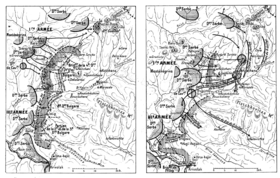Battle of Bregalnica
| ||||||||||||||||||||||||||||||
The Battle of Bregalnica was fought between the Kingdom of Bulgaria army and the Kingdom of Serbia during the Second Balkan War. It was the largest battle of the war.
In Bulgarian history, the battles of Bregalnica and Kalimanci are considered as two parts of one single battle ending with the defeat of the Serbian forces.
Introduction
According to the military convention between Serbia and Bulgaria from 13 March 1912 that predated the First Balkan War, the main Bulgarian forces were to be used on the Thracian front (Eastern theater), while the whole Serbian army and one Bulgarian army of 100,000 men were to be used against the Ottoman army in Macedonia (Western theater). Since the Bulgarians did not engage agreed forces in the Western theater but sent them instead to the Eastern theater, the main burden of fighting in Macedonia was left to the Serbian army. The Greek army also engaged Ottoman forces in the Western theater and, much more important, used its superior navy to block Ottoman naval lines in the Aegean Sea thus preventing Ottoman reinforcements from Asia coming to the European part of empire.
The Serbian army defeated the Ottoman Vardar army in the three major battles at Battle of Kumanovo, Battle of Prilep and Battle of Bitola and effectively conquered the entire Vardar Macedonia (roughly the present-day Republic of Macedonia) as well as territories of northern and central Albania. In the same time the Greek army defeated smaller Ottoman forces in the Epirus and Aegean Macedonia and thus with the Serbian army practically ended Ottoman military presence in the areas of Macedonia, Albania and Epirus. Meanwhile, the Bulgarian army in the eastern theater of war defeated the main Ottoman forces at Kırkkilise and Lüleburgaz but were eventually stopped at the fortified positions at Çatalca and engaged in a long siege of Edirne. Since the failure of Bulgarians at Edirne could put in jeopardy the results of the entire war, including the Serbian victories in Macedonia, Serbia sent two infantry divisions and much needed heavy artillery to aid Bulgarians at Edirne. Reinforced with Serbian troops Bulgarians eventually managed to capture Edirne which ultimately lead to the Ottoman defeat in the war and signing the peace Treaty of London on 30 May 1913.
Since the treaty of London proclaimed independent Albanian state which included much of the territories that were assigned to Serbia in pre-war Serbian-Bulgarian agreement, Serbia sought compensation on the other side, most notably in Vardar Macedonia which was conquered and still held by the Serbian army. The Serbian-Bulgarian agreement from 1912. made no clear division of Macedonia between Serbia and Bulgaria since it had left large area of it as disputed territory allowing Russian arbitration in the case of dispute. Serbia felt that it was damaged with the loss of the territories in Albania and that its gains were not proportional to its efforts in war, especially because of the sending of the additional forces to Edirne and Bulgarian failing to engage agreed forces in western theater. Using this argument Serbia demanded that the territories that were conquered in Macedonia by the Serbian army should be given to Serbia especially because Bulgaria gained much more territories in the east then it was initially planned by the Serbs. Since the Greece also had unresolved issue with the Bulgaria in Aegean Macedonia two states approached each other in a defensive alliance against Bulgaria.
References
Sources
- Savo Skoko Vojvoda Radomir Putnik Vol.1; Beogradsko Grafičko-Izdavčki Zavod, 1984.
- Hall, Richard C. (2000). The Balkan Wars, 1912–1913: Prelude to the First World War. Routledge. ISBN 0-415-22946-4.
Notes
- The numbers of the strength of Serbian Army do not indicate the exact strength of the forces deployed during the Battle of Bregalnica but rather the entire strength of the Serbian Army in Macedonia (the Operational group South, which included the combined 1st and 3rd Armies) at the beginning of hostilities.

